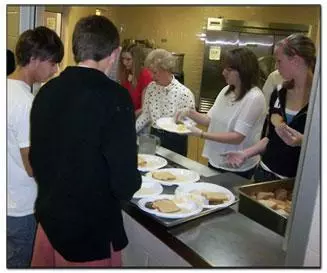December 2012

My friend Andrew recently hosted a dinner as a "thank you" to several friends – all long-time volunteers at Greensboro Urban Ministry (GUM) - who had helped him with a special project for GUM. At one point, with several great conversations going on, I just barely picked up a comment by Andrew - "There's one thing I've learned as an attorney over the years - everything has a cost."
For some reason, Andrew's comment - at just that time, and in just the right environment - gave me a new insight about homelessness. Let me share it with you.
Homelessness Misconceptions
A common misconception is that all persons experiencing homelessness are in the same circumstances - and that's just not the case. There are actually two broad groups of persons, each with widely different characteristics and needs.
Chronically Homeless
The first group is the "chronically homeless." Making up about 10% to 15% of the clients served by GUM and other homeless shelters nationwide, these are single adults who have both:
- Lacked permanent housing for over a year (or a repeated lack of such housing over three years).
- A disabling condition stemming from illness (either mental or physical) or from substance addiction - unfortunately, most have both mental illness and substance addiction.
Even at only 10% to 15% of all homeless persons, this group is very expensive to serve. As the Guilford County/High Point/Greensboro Task Force on Ending Homelessness wrote in their June 2007 Ten Year Plan report, this group utilizes "large amounts of public and private crisis care services, including emergency rooms, mental health facilities, police time and jails, without achieving housing or personal stability."
That same report presented eight case studies it examined in Guilford County, and concluded it was less expensive - by over $10,000 a year per person served across all affected entities - and more effective to provide these individuals with subsidized housing and the appropriate supportive services. This is called a "Housing First" model.
Unfortunately, the Housing First implementation runs aground when our City or Town Councils, our County Board of Commissioners, and our hospitals do their budgets. Each is responsible for a pool of money to fund its various services - and we know Housing First would reduce the number and cost of services each provides. Yet, what entity is willing to give up a slice of scarce budget to fund this program?
Situationally Homeless
The second group is the "situationally homeless." This group makes up the vast majority - 85% to 90% - of people served. Working jobs at or just above the minimum wage, these people have a sudden turn of bad luck - getting sick, caring for an ailing family member, having an unexpected car repair. These folks face a tough choice - "Do I stay out of work and get well, do I buy medicine for my sick mother, do I repair my car so I can keep my job ... or do I pay my rent?" Working at a low wage job allows virtually no room for unexpected events. Read more articles on homelessness

The good news - people in this second group only stay at GUM a few weeks, then leave. They use the time to find a new job, and to save up their wages - and are typically never back in a shelter again.
The bad news - there are few jobs for these people. Contrary to the opinions of some, the great majority of GUM clients do want to work, to have a secure job, to earn a decent living. They are not looking for a handout - they are merely seeking a "hand up."
The number of clients GUM serves increased sharply following the Financial Crisis of 2007-2008, and the resulting Great Recession - businesses of all sizes laid off employees, and lower income jobs were disproportionately affected.
Homelessness Statistics
In 2005, the 100 beds at GUM were occupied by, on average, 88 people a day - more in the winter, fewer in the summer. Just a year later, this rose to 93 people, then to 97 in 2007, and 103 in 2008. During the winter of 2007-2008, many people slept on floor mats or in the lobby chairs - and this was even after many area congregations opened their facilities to serve as Winter Emergency shelters. The numbers for 2009, 2010, and 2011? Similarly high, as are the year-to-date numbers for 2012.
My new insight? The linkage of situational homelessness and "creative destruction" - things being destroyed to make way for something new. Such a noble-sounding phrase, "creative destruction" conjures up images of an entrepreneur having a brilliant idea, bringing it to market, being wildly successfully, and siphoning off - or even destroying - the revenue stream of existing companies.
What came of Wall Street's creativity with the complex financial instruments called mortgage-backed securities? A global financial crisis triggering a global recession. And what happens when the income stream being destroyed crosses over from corporate revenues to the income stream known as a paycheck? Record unemployment, and record numbers of homeless individuals. These numbers have a cost – a financial cost, certainly, yet also emotional and mental costs of low self esteem, admittedly, hard to quantify, yet very large, and all too real.
Roll Up Your Sleeves
One thing I've always admired about the Greensboro community - people are willing to roll up their sleeves, pitch in, and do what they can to help others. Contributing time, talent, and treasure - we do these things because they're the right things to do. Volunteerism is a key part of our community's DNA, and should be a genuine source of pride for us all. Even though we still have a ways to go to end homelessness, let's be mindful of what we already do - and then lets do them more.
Want to help move towards our goal of ending homelessness?
- Ensure your elected representatives support funding for Housing First, and also * for job training programs to help people learn skills for jobs being created in our area.
- If you're an employer, consider hiring someone based on good recent performance, even if their past is not spotless.
- Organize a food drive. Over time, many small drives adds up! Last year, GUM received over 1 million pounds of donated food. Had more donations been available, they would have been put to immediate use.
- Contribute time, money, or both to GUM or similar agencies.
- Volunteer at a Winter Emergency shelter - bring a meal, or stay overnight. To get involved, click here.
- Volunteer at the Interactive Resource Center - nurses, social workers, tutors, barbers and stylists (it's hard to look good for an interview when you're homeless), and others are needed. To get involved, click here.
- Volunteer at the annual Missions of Mercy Dental Clinic - dentists, dental assistants, hygienists, nurses, and others are all needed to provide services or screening.
- To learn more about the clinic, click here.
- To get involved: Contact Lelia Moore, head of the Congregational Nurse Program at Cone Health, at 336.832.8602.
- Learn about Partners Ending Homelessness, the agency planning and coordinating homeless service delivery in Guilford County.
- For some sobering statistics, click here.
- For information about serving on Action Teams, click here.
- For a list of partner organizations, click here.
- For information on becoming a member, click here.
Andrew was right - "Everything has a cost." He and I, like many others in our community, see that cost and are working to pay it down. Each week, the two of us and fifteen to twenty of our friends gather as the Friday Breakfast Community to serve guests at GUM, and pay another small installment on the tragic human cost of creative destruction.
![]()
Todd Herman is president of Todd Herman & Associates PA and actively participates at First Lutheran Church. For ideas on getting involved, contact GUM at 336.553.2642, or visit www.toddherman.com/getinvolved





